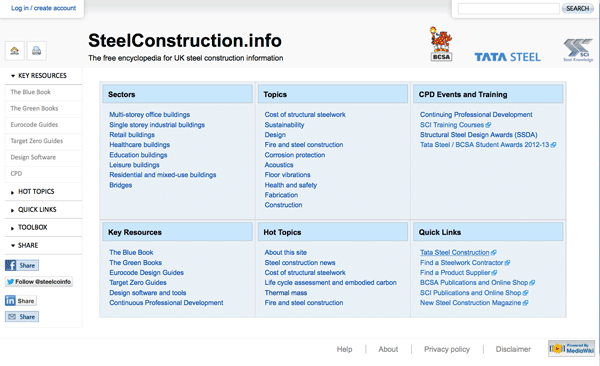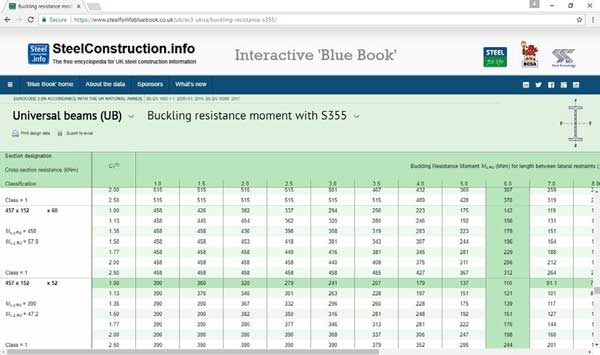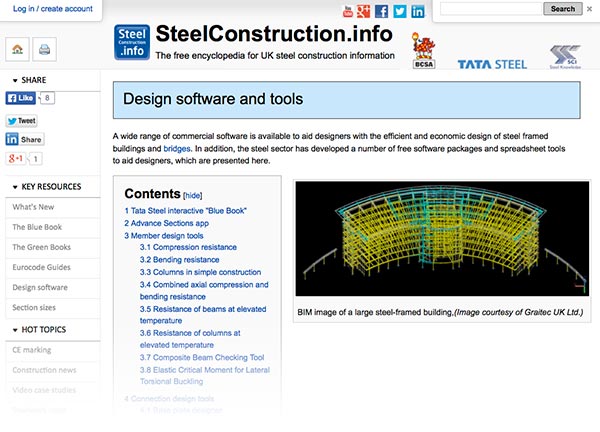Projects and Features
New information resource
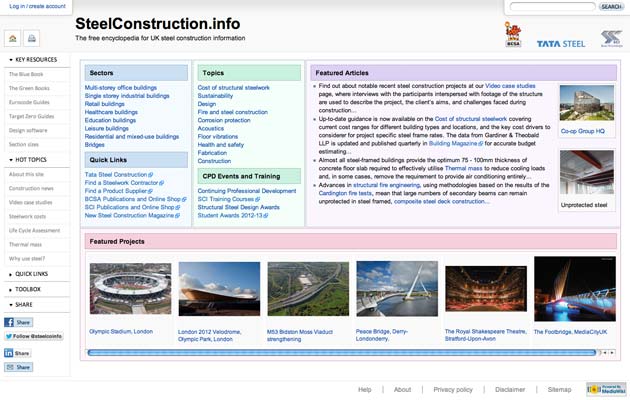 The recently launched steel sector website – www.steelconstruction.info – contains six home page headings, one of which, Sectors, is explained here.
The recently launched steel sector website – www.steelconstruction.info – contains six home page headings, one of which, Sectors, is explained here.
Launched last October the www.steelconstruction.info website brings together all the technical and cost information designers need on steel construction.
This free encyclopaedia for the steel sector has been specifically designed to be as comprehensive as possible, while at the same time being user friendly.
In response to comments from architects, all 100 plus articles on the website have been edited to improve their appearance, while the home page has been redesigned adding colour and images, which should go live later this month (January).
Other recently added enhancements include a raft of new articles, video case studies and a new link to steel section sizes, while a video function to play through a YouTube channel is currently under construction.
The home page of the website has six main topics (Sectors, Key Resources, Topics, Hot Topics, CPD Events and Training, and Quick Links) which the user can choose from. These six topics then have a vast number of internal links on all relevant steel information. In the forthcoming issues of New Steel Construction we will have articles on each of the six topics, beginning in this issue with Sectors.
Since the launch the site has evolved and will continue to be updated. You can follow the updates at:
.
Click on Sectors and eight options are available:
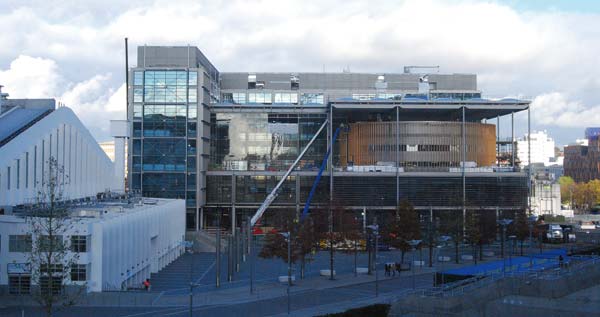 Steel dominates this sector as the majority of the UK’s high rise office blocks are constructed with a steel frame. Cost, value for money, flexibility, sustainability and speed of construction are important criteria project teams have to consider when choosing a framing material. In this section of the website there are articles explaining why steel comes out on top for these issues and consequently is the material of choice for this sector.
Steel dominates this sector as the majority of the UK’s high rise office blocks are constructed with a steel frame. Cost, value for money, flexibility, sustainability and speed of construction are important criteria project teams have to consider when choosing a framing material. In this section of the website there are articles explaining why steel comes out on top for these issues and consequently is the material of choice for this sector.A number of case studies of high profile and prominent buildings, are here, including video case studies of the Walbrook Building, London and the Co-operative HQ in Manchester, two projects that achieved client aspirations by using steel.
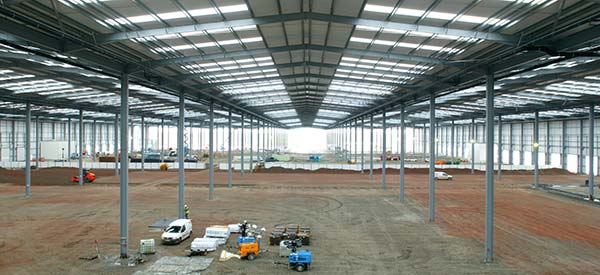 Single storey buildings are by far the largest sector of the UK structural steelwork market, representing nearly two thirds of total activity. These structures have a wide variety of uses and on this page of the website the different forms of steel construction utilised for this sector – portal frames, lattice structures and suspended structures – are all explored. Highlighting the profusion of uses single storey industrial buildings have, case studies include a paper mill, a recycling plant, a manufacturing facility and distribution centres.
Single storey buildings are by far the largest sector of the UK structural steelwork market, representing nearly two thirds of total activity. These structures have a wide variety of uses and on this page of the website the different forms of steel construction utilised for this sector – portal frames, lattice structures and suspended structures – are all explored. Highlighting the profusion of uses single storey industrial buildings have, case studies include a paper mill, a recycling plant, a manufacturing facility and distribution centres.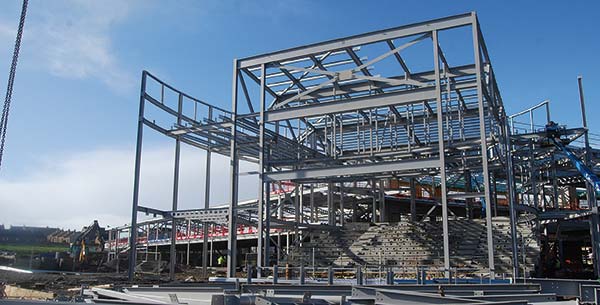 A variety of types of steel construction are needed for the educational sector, that are able to achieve strict performance targets, such as acoustic, thermal or ventilation requirements and at the same time provide flexible spaces to suit a variety of uses. There is also a need to consider how the buildings can be adapted and reconfigured to meet future educational needs.
A variety of types of steel construction are needed for the educational sector, that are able to achieve strict performance targets, such as acoustic, thermal or ventilation requirements and at the same time provide flexible spaces to suit a variety of uses. There is also a need to consider how the buildings can be adapted and reconfigured to meet future educational needs.Steel construction is able to address all these aspects and is routinely used to deliver cost-effective and sustainable educational buildings. Offsite manufacture improves safety and construction speed, reduces waste and disturbance, and results in better quality.
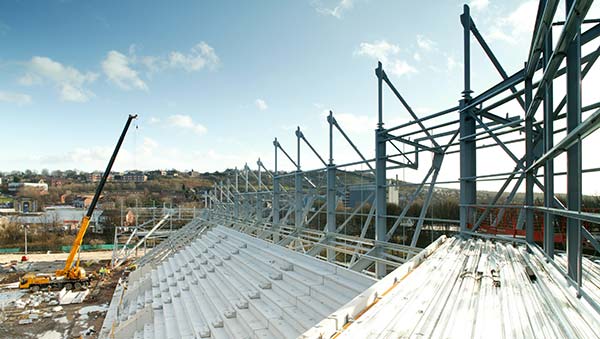 Leisure buildings include stadiums, sports arenas, swimming pools and theatres, all of which are suited to steel construction. These structures vary in size but all share the need for long span column free spaces. This can easily be achieved with steelwork and in this section all forms of suitable construction are explained, from continuous frames, portal frames and braced frames to long span options with trusses, cellular beams and curved beams. Case studies include the London 2012 Olympic Stadium, the Amex Stadium in Brighton and the Young Vic Theatre.
Leisure buildings include stadiums, sports arenas, swimming pools and theatres, all of which are suited to steel construction. These structures vary in size but all share the need for long span column free spaces. This can easily be achieved with steelwork and in this section all forms of suitable construction are explained, from continuous frames, portal frames and braced frames to long span options with trusses, cellular beams and curved beams. Case studies include the London 2012 Olympic Stadium, the Amex Stadium in Brighton and the Young Vic Theatre.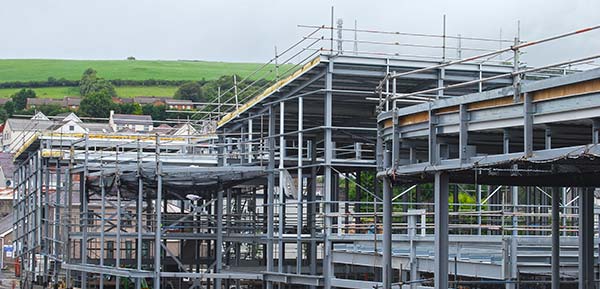 The retail sector is very competitive and therefore the ability of steel construction to deliver flexible, lightweight solutions fast and cost effectively make it the material of choice. Aspects of construction highlighted within this section consist of portal frames, trusses, braced frames, composite construction, long span beams, building envelopes and floor systems. Many of these construction techniques will arise on the same project and to highlight this, featured case studies include some large-scale shopping centres in England, Wales and the Republic of Ireland.
The retail sector is very competitive and therefore the ability of steel construction to deliver flexible, lightweight solutions fast and cost effectively make it the material of choice. Aspects of construction highlighted within this section consist of portal frames, trusses, braced frames, composite construction, long span beams, building envelopes and floor systems. Many of these construction techniques will arise on the same project and to highlight this, featured case studies include some large-scale shopping centres in England, Wales and the Republic of Ireland.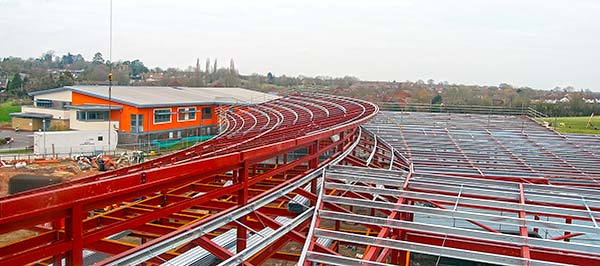 A number of specific criteria will always apply to the healthcare sector and steel construction can satisfy them all. Attributes of steel construction explained in this section include speed of construction, flexibility and adaptability, quality, minimised disruption, cleanliness, vibration and acoustic performance, service integration, thermal insulation of cladding, and environmental benefits.
A number of specific criteria will always apply to the healthcare sector and steel construction can satisfy them all. Attributes of steel construction explained in this section include speed of construction, flexibility and adaptability, quality, minimised disruption, cleanliness, vibration and acoustic performance, service integration, thermal insulation of cladding, and environmental benefits.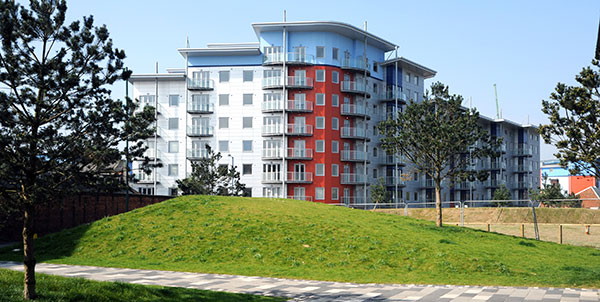 The use of steel in the housing and residential building sector has grown over the last 10 years primarily because of the growing appreciation of the performance benefits that arise from off site construction, which is particularly important in urban or mixed-use buildings. Key issues, highlighted in this section, for the design of residential buildings include procurement, economics, programme, sustainability and service integration. Case studies include student accommodation at Ducie Court in Manchester, residential apartments adjoining a commercial development in central London (Park House), and student accommodation constructed atop a large shopping centre at Trinity Square in Gateshead.
The use of steel in the housing and residential building sector has grown over the last 10 years primarily because of the growing appreciation of the performance benefits that arise from off site construction, which is particularly important in urban or mixed-use buildings. Key issues, highlighted in this section, for the design of residential buildings include procurement, economics, programme, sustainability and service integration. Case studies include student accommodation at Ducie Court in Manchester, residential apartments adjoining a commercial development in central London (Park House), and student accommodation constructed atop a large shopping centre at Trinity Square in Gateshead.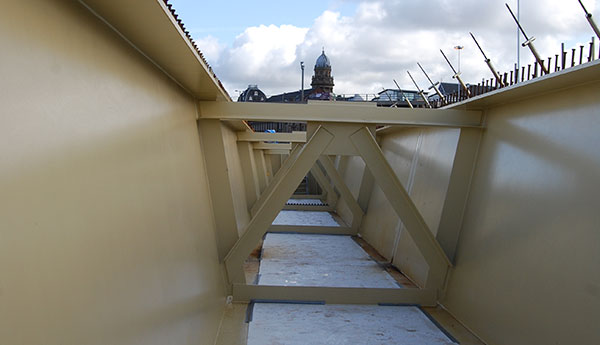 Steel is widely used around the world for the construction of bridges from the very large to the very small. These encompass a variety of types and forms of construction including: beam bridges, box girder bridges, truss bridges, arch bridges, cable stayed bridges and suspension bridges, all of which are highlighted and explained in this section. Landmark steel bridges embody a number of design attributes, which are emphasised in eight case studies including Derry/Londonderry’s Peace Bridge, the Clyde Arch Bridge in Glasgow and the Borough High Street Bridge in London.
Steel is widely used around the world for the construction of bridges from the very large to the very small. These encompass a variety of types and forms of construction including: beam bridges, box girder bridges, truss bridges, arch bridges, cable stayed bridges and suspension bridges, all of which are highlighted and explained in this section. Landmark steel bridges embody a number of design attributes, which are emphasised in eight case studies including Derry/Londonderry’s Peace Bridge, the Clyde Arch Bridge in Glasgow and the Borough High Street Bridge in London.







